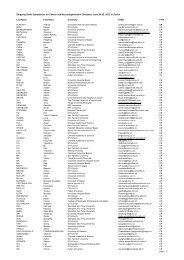Stepping Stone Symposia Conference on Medical Technology ...
Stepping Stone Symposia Conference on Medical Technology ...
Stepping Stone Symposia Conference on Medical Technology ...
Create successful ePaper yourself
Turn your PDF publications into a flip-book with our unique Google optimized e-Paper software.
Jeffrey HUBBELL<br />
EPF Lausanne<br />
jeffrey.hubbell@epfl.ch<br />
SSSTC <str<strong>on</strong>g>Stepping</str<strong>on</strong>g> <str<strong>on</strong>g>St<strong>on</strong>e</str<strong>on</strong>g> Symposium <strong>on</strong> <strong>Medical</strong> Technologies, 27–28 September 2012<br />
Research interests<br />
Biomaterials; tissue engineering; regenerative medicine; immunoengineering<br />
Educati<strong>on</strong>al history<br />
BS, Chemical Engineering, Kansas State University; PhD, Chemical Engineering, Rice University<br />
Previous positi<strong>on</strong>s<br />
Previous to joining EPFL, Prof. Hubbell was <strong>on</strong> the faculty at the ETH Zurich and University of Zurich, at the<br />
California Institute of <strong>Technology</strong>, and the University of Texas at Austin.<br />
Jeffrey A. Hubbell<br />
Engineering the regenerative microenvir<strong>on</strong>ment<br />
Growth factor; extracellular matrix<br />
In natural situati<strong>on</strong>s, angiogenic growth factors such as vascular endothelial growth factor (VEGF) are present in a<br />
matrix-bound form, yet therapeutic use of such growth factors has focused <strong>on</strong> applicati<strong>on</strong> in soluble form. To<br />
explore matrix immobilizati<strong>on</strong> of angiogenic growth factors, we have explored two approaches, both in the<br />
c<strong>on</strong>text of fibrin as a surgically-relevant matrix: enzymatic c<strong>on</strong>jugati<strong>on</strong> of variant forms of the growth factors, and<br />
complexati<strong>on</strong> with recombinant variants of fibr<strong>on</strong>ectin.<br />
Angiogenic growth factors such as VEGF were engineered so as to c<strong>on</strong>tain a substrate domain for the coagulati<strong>on</strong><br />
transglutaminase factor XIIIa, modeled after the N terminus of alpha2 plasmin inhibitor. To provide a release<br />
mechanism, an enzymatic substrate was included in the growth factor variant between the transglutaminase<br />
substrate and the growth factor domain, taken as either a plasmin substrate domain or a matrix<br />
metalloproteinase domain. Thus, we have explored the activity of tripartite fusi<strong>on</strong> proteins for inducing<br />
angiogenesis. We have most thoroughly studied the variant of VEGF-A, and we have dem<strong>on</strong>strated that the variant<br />
form of VEGF-A induces more angiogenesis than the wild type and induces a less hyperpermeable phenotype, both<br />
in the chick chorioallantoic membrane and in mouse skin.<br />
To explore n<strong>on</strong>covalent immobilizati<strong>on</strong> up<strong>on</strong> matrices, we have engineered a fibrin-binding domain of fibr<strong>on</strong>ectin,<br />
c<strong>on</strong>taining the 12th-14th type III repeat (which was known to bind VEGF-A). In studies of the 12th-14th type III<br />
repeat, we determined that the growth factor binding activity of this domain was rather promiscuous, binding to<br />
VEGF-A, VEGF-C, PDGF-AA, PDGF-BB and PDGF-AB, for example, in additi<strong>on</strong> to a wide number of other growth<br />
factors. Incorporati<strong>on</strong> of this domain into fibrin, also through transglutaminase activity, provides a powerful and<br />
generalizable method to retain such growth factors into surgical matrices.<br />
Page | 28



